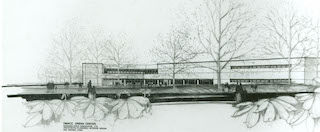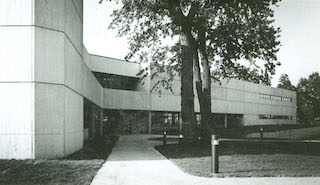
Top: Conceptual design for DMACC Urban Campus, 1978. Photo courtesy of DMACC Archives

Urban Campus in 1980. Photo courtesy of DMACC Archives
Nov/Dec 2022
(Volume 14, Issue 6)
By Matthew Walsh
“I cannot offer you money, position, or fame. The first two you have. The last, from the place you now occupy, you will not doubt achieve. These things I now ask you to give up. I offer you in their place work-hard, hard work—the task of bringing a people from degradation, poverty, and waste to full manhood.” With these powerful words, Booker T. Washington convinced George Washington Carver to leave his comfortable post at Iowa State for a teaching position at Tuskegee Institute in 1896. Seventy-five years later, Tuskegee repaid Iowa with Zack Hamlett Jr., a great educator who played a pivotal role in the birth and growth of Des Moines Area Community College’s Urban Campus.
Coming of age in rural Tennessee, segregation denied Hamlett bussing to school, forcing the youngster to walk 12 miles daily to class. After graduating from Tuskegee, Hamlett tried farming, but the boll weevil destroyed his crop. Hamlett shifted to a career in education, graduated from Michigan State University, and started teaching. In 1971, Hamlett accepted a special project coordinator position at DMACC. He recalled, “My specific function was to come up with ways and means to offer educational opportunities to disadvantaged people.” The state’s most disadvantaged resided in Des Moines, about 20 minutes south of DMACC’s Ankeny Campus.
In 1972, Hamlett oversaw the Urban Higher Education Center. This grant-funded program brought high school completion, adult basic education, college referral and hope to inner-city residents. The center enrolled about 200 students at old Dowling Catholic High School, which had been renamed The King Center for Human Development. Along with DMACC, 11 other groups provided social services such as kindergarten, free meals and pregnancy counseling. Within two years, enrollment grew to more than 1,800, and cramped classrooms meant pupils did not even have room to sit and study. By 1974, Dowling officials planned to sell the King Center. DMACC had borrowed against its levy through 1977 and did not have the funds to purchase; the long fight over the future of Urban Campus began.
DMACC Superintendent Paul Lowery informed students of the move from 9th and Washington. Possibilities for the future campus included mostly downtown sites or old public-school buildings near King Center. Attendees feared relocating downtown jeopardized the mission of Urban Campus. In protest, they wrote, “A downtown location is being sought by the Des Moines business community for the purpose of educating their workers … Students sense a desire of our administration to gain status by being downtown rather than taking pride in our urban, but shabby campus … The Urban Campus was explicitly designed to facilitate upward mobility of those persons who would normally be intimidated away by higher education. This right should not so easily be taken away from those students who need this facility the most.”
That summer of 1974, DMACC Urban moved to the former Sabin Elementary on 5th and College Avenue. Just four blocks from old Dowling, the makeshift campus stayed in the northside and it boasted twice the space of King Center. The three-year lease bought time while college officials sought a permanent solution. Meanwhile, Lowery wrote Gov. Robert Ray, asking the state legislature to fund construction of a $3 million Urban Campus. He told Ray inner-city residents looked to college as a “way out of the slums.” Students met with and lobbied legislators. Diane Bidwell, a single mother seeking a nursing degree, explained, “I will someday be a substantial taxpayer because of the Urban Campus. This is a wonderful steppingstone for those of us to get back in education … We have a lot to give back to you … if you will help us.” Doris Tucker, an alumna and regional director of area preschools, described how DMACC Urban uplifted vulnerable populations. Despite their efforts, legislators outside Des Moines had little interest in funding a project that did not benefit their constituents.
TO READ THE ENTIRE STORY AND OTHER FASCINATING STORIES ABOUT IOWA HISTORY, subscribe to Iowa History Journal.
